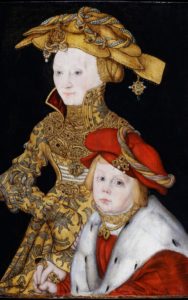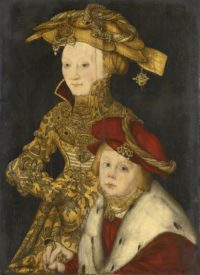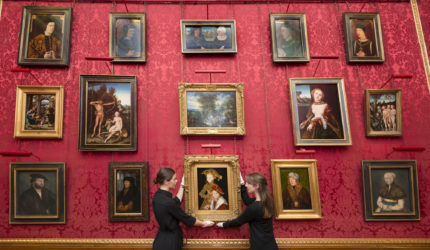 Pigeon tendons have confirmed that Queen Victoria was right and a slew of subsequent Royal Collection curators were wrong: a painting she acquired is an authentic work by Lucas Cranach the Elder. Victoria bought it in 1840 as a Christmas present for her husband Prince Albert who was an avid collector of his countryman’s work and ultimately added a dozen paintings by the master himself or his workshop to the Royal Collection.
Pigeon tendons have confirmed that Queen Victoria was right and a slew of subsequent Royal Collection curators were wrong: a painting she acquired is an authentic work by Lucas Cranach the Elder. Victoria bought it in 1840 as a Christmas present for her husband Prince Albert who was an avid collector of his countryman’s work and ultimately added a dozen paintings by the master himself or his workshop to the Royal Collection.
Portrait of a Lady and her Son (ca. 1510–40) is a double portrait of an Electress of the Holy Roman Empire and her apple-cheeked son wearing exquisite finery and holding hands. She and Albert did not question its attribution as a genuine Cranach, but by the early 20th century Royal Collection Trust experts reluctantly acknowledged that it was not by Cranach or even by his workshop. Instead, they believed it was painted by Franz Wolfgang Rohrich (1787–1834), who was an extremely successful Cranach forger. He cranked out more than 40 copies of the Electress holding her son’s hand and sold them to deep-pocketed collectors all over Europe. It took decades for people to cotton on to Rohrich’s fraudulent imitation game, and many of his pseudo-Cranachs are still in Europeans private and public collections.
 Royal Collection Trust’s reasoning was that the style, principally the tender physical and emotional connection between mother and son, was not something seen in Cranach’s oeuvre. His figures are remote and stylized. Holding Mommy’s hand is not in Lucas Cranach the Elder’s wheelhouse. Also, while the Rohrich versions were everywhere, there was no painting that could be definitively identified as a Cranach original modified by the forger.
Royal Collection Trust’s reasoning was that the style, principally the tender physical and emotional connection between mother and son, was not something seen in Cranach’s oeuvre. His figures are remote and stylized. Holding Mommy’s hand is not in Lucas Cranach the Elder’s wheelhouse. Also, while the Rohrich versions were everywhere, there was no painting that could be definitively identified as a Cranach original modified by the forger.
The issue returned to the fore recently when the Royal Collection Trust agreed to loan the portrait to an exhibition in Dusseldorf that took place earlier this year. RCT conservators and curators worked with Cologne’s University of Applied Sciences to study the painting in depth with technology that wasn’t invented when the early 20th century curators made the deattribution decision.
In collaboration with TH Köln (the University of Applied Sciences, Cologne), Royal Collection Trust’s conservators and curators examined the work ahead of its loan to the major exhibition Cranach der Alterer: Meister Marke Moderne at the Museum Kunstpalast, Düsseldorf in spring 2017. Infrared reflectography was used to look beneath the paint surface, revealing preliminary underdrawing typical of Cranach’s work. Analysis of the pigments, metal leaf and the application of paint provided further evidence that the portrait was a work of the 16th century.
Finally an x-ray of the painting revealed that a fibrous material had been used in the preparation of the panel. Analysis of similar fibres on other works by Cranach has identified them as tendons, and in one instance DNA analysis had shown them to be pigeon tendons. Sixteenth-century glue recipes often included pigeon tendons to strengthen the mixture and counteract the natural warping and splitting of the wood.
The evidence was reviewed by Professor Dr Gunnar Heydenreich of TH Köln, an expert on Lucas Cranach the Elder, who confirmed that the painting was an original work by the master from which it appears all later versions derive.
The Royal Collection Trust conservators are ecstatic at the reattribution of the portrait to Cranach and have wasted no time in giving it a prominent position on public display. It has been installed at eye-level in the King’s Dressing Room at Windsor Castle where it will keep company with its brethren by Cranach and his workshop, including Apollo and Diana (ca. 1526), Lucretia (1530), and The Judgement of Paris (ca. 1530–35).
